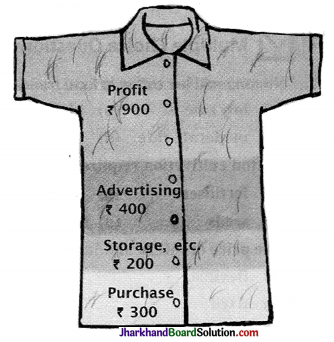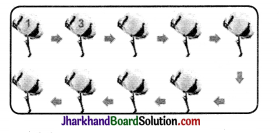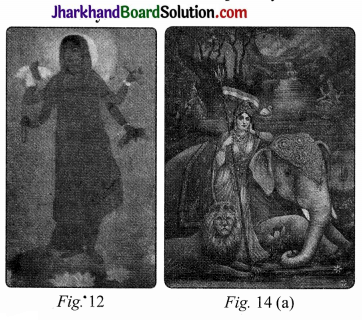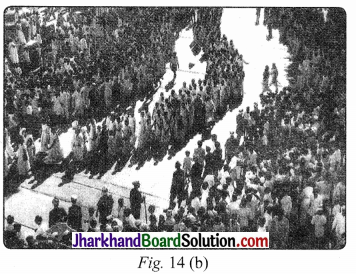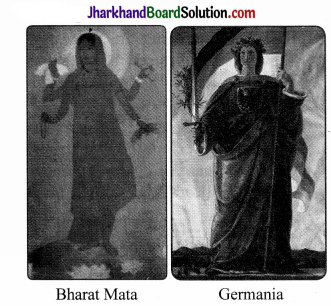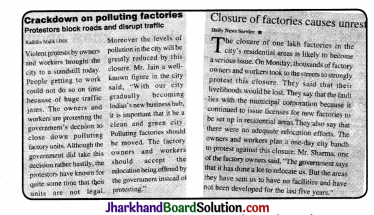Jharkhand Board JAC Class 10 Hindi Solutions मौखिक अभिव्यक्ति बोलना Questions and Answers, Notes Pdf.
JAC Board Class 10 Hindi मौखिक अभिव्यक्ति बोलना
(i) भाषण, वाद-विवाद –
भाषण देना एक अनूठी कला है जिसे थोड़े से अभ्यास से सीखा जा सकता है। अच्छा भाषण देने वाला व्यक्ति आज के युग में शीघ्र ही ख्याति प्राप्त कर लेता है। राजनीति, धर्म आदि तो ऐसे क्षेत्र हैं जहाँ अच्छा भाषण देने वालों ने बहुत नाम कमाया है।
भाषण देने की कला मुख्य रूप से दो आधारों पर टिकी हुई है –
- उच्चारण और वाक्य संरचना
- शारीरिक हाव-भाव।

अच्छे भाषण के गुण –
रोचकता – अच्छा भाषण वही कहलाता है, जो अपने भीतर रोचकता का गुण छिपाए हुए हो। उसमें श्रोता को अपने साथ बाँध लेने का गुण होना चाहिए। भाषण ऐसा होना चाहिए कि श्रोता का ध्यान पूरी तरह से भाषण देने वाले की ओर लगा रहे। रोचकता को बढ़ाने के लिए भाषण में काव्यांशों, चुटकलों, उदाहरणों, चटपटी बातों आदि का स्थान-स्थान पर प्रयोग किया जाना चाहिए।
स्पष्टता – भाषण में भाव, विषय और भाषा की स्पष्टता होनी चाहिए। भाषण देने वाले को पूर्ण रूप से पता होना चाहिए कि उसने कहाँ और क्या बोलना है। उसके मन में विचारों की व्यवस्था पहले से ही होनी चाहिए। उसे विषय पर पूर्ण रूप से अधिकार होना चाहिए। उसकी भाषा में सरलता और स्पष्टता निश्चित रूप से होनी चाहिए।
ओजपूर्ण – वक्ता को भाषण देते समय उत्साह और ओज का परिचय देना चाहिए। उसकी वाणी ऐसी होनी चाहिए जो श्रोताओं की नस- नस में मनचाहा जोश भर दे। उसके भाषण में ऐसे भाव भरे होने चाहिए कि श्रोताओं को लगे कि वे वही तो सुनना चाहते थे, जो वक्ता कह रहा है।
पूर्णता – भाषण में पूर्णता का गुण होना चाहिए। श्रोता को सदा ऐसा लगना चाहिए कि वक्ता के द्वारा कही जाने वाली बात बिलकुल पूरी है और उसमें किसी प्रकार का कोई अधूरापन नहीं है। वक्ता को किसी भी निश्चित उद्देश्य की पूर्ति की ओर स्पष्ट संकेत करना चाहिए।
श्रोताओं की रुचि के अनुसार – भाषण का औचित्य सीधा श्रोता से जुड़ा होता है। वक्ता को ऐसे विषय और उदाहरण चुनने चाहिए जो श्रोताओं की रुचि के अनुसार हों। श्रोताओं की आयु, मनोदशा और परिस्थितियों को समझ कर ही उसे बोलना चाहिए। उसे दैनिक जीवन से विभिन्न प्रसंगों को लेकर उन्हें अपने भाषण का हिस्सा बनाना चाहिए। विषय से जुड़ी विभिन्न समस्याओं को श्रोताओं के सामने उठाना चाहिए और उन समस्याओं का तर्कपूर्ण समाधान बताना चाहिए। उसे वही बात कहनी चाहिए जो कोरी कल्पना पर आधारित न होकर यथार्थ जीवन से जुड़ी हुई हो।
स्वर में आरोह-अवरोह – भाषण देते समय वक्ता को सीधी – सपाट भाषा का प्रयोग नहीं करना चाहिए। उसे श्रोताओं को संबोधित करते समय अपने स्वर में आरोह और अवरोह की ओर विशेष ध्यान रखना चाहिए। उसे स्थान-स्थान पर प्रश्न उपस्थित करके उनका समाधान प्रस्तुत करना चाहिए।
तथ्यात्मकता – भाषण में तथ्यों और सूचनाओं को प्रस्तुत करके श्रोताओं को अपनी ओर सरलता से आकृष्ट किया जा सकता है। इससे जिज्ञासा तो बढ़ती ही है पर साथ-ही-साथ वक्ता के ज्ञान का परिचय भी मिलता है।
क्रियात्मक अभिनय – वक्ता अपने चेहरे पर आए भावों, हाथों के संकेतों और गर्दन की गति से भावों के प्रकाशन में नए आयाम जोड़ सकता है। क्रियात्मक अभिनय स्वाभाविक होना चाहिए। इसकी अति कृत्रिमता को जन्म देती है जो श्रोताओं को कदापि सहन नहीं हो पाती। संभाव्यता – भाषण कल्पना के आधार पर टिका हुआ नहीं होना चाहिए। वक्ता मंच से जो भी कहे वह प्रामाणिक होना चाहिए। किसी पर झूठे आक्षेप तो कभी नहीं लगाए जाने चाहिए।

भाषणों के कुछ उदाहरण –
1. आइए, हम भी बनें जल – मित्र
मंच पर आसीन मुख्य अतिथि महोदय, सम्माननीय प्राचार्य जी, आदरणीय अध्यापकगण और मेरे प्रिय साथियो ! आज की प्रतियोगिता में मेरे संभाषण का विषय है – ‘आइए हम भी बनें जल – मित्र।’
जल हमारा जीवन है। हम भोजन के बिना तो कुछ दिन या कुछ सप्ताह जीवित रह सकते हैं पर जल के बिना अधिक देर तक जीवित नहीं रह सकते। हमारे देश में जल संकट बढ़ता जा रहा है। हम इस संकट का जिस स्तर पर अनुमान लगा रहे हैं, संकट उससे कहीं अधिक गंभीर है। एक रिपोर्ट के अनुसार गंगा, भागीरथी और अलकनंदा बेसिन के 564 ग्लेशियर तेज़ी से सिमट रहे हैं।
इनमें से आधे से अधिक सन 2075 तक पूरी तरह समाप्त हो जाएँगे। हार्वर्ड बिजनेस स्कूल के अनुसार दिल्ली के भू-जल भंडार सन 2015 तक पूरी तरह समाप्त हो जाएँगे। केंद्रीय जल आयोग की रिपोर्ट के अनुसार अप्रैल 2006 में भाखड़ा सहित उत्तर भारत के प्रमुख बाँधों में क्षमता से 70% – 90% तक पानी की कमी थी। मध्य प्रदेश के गांधी सागर बाँध में जल का स्तर शून्य पर था।
साथियो, निश्चित रूप से इसके लिए ज़िम्मेदार हम हैं। हमने जल को सहेज कर नहीं रखा। हमने बड़ी बेरहमी से भू-जल का दोहन किया है पर इतना निश्चित है कि प्रकृति हमें लंबे समय तक ऐसा नहीं करने देगी। जब जल ही नहीं रहेगा तो हम उसका दोहन कैसे कर सकेंगे ? पर ज़रा सोचो तो, तब हम सबका क्या होगा ? हमारी आने वाली पीढ़ियों का क्या होगा ?
स्पष्ट है कि जल के अनियंत्रित उपयोग पर अंकुश लगाना होगा और स्थिति को अधिक बिगड़ने से पहले हमें एक साथ दो मोर्चों पर काम करना होगा – वर्षा के जल का संग्रहण तथा उपलब्ध जल का बेहतर प्रबंधन।
हमें वर्षा के जल को सीधा भू-गर्भ में उतार देने का रास्ता अपनाना चाहिए क्योंकि वर्षा जल बिलकुल स्वच्छ होता है। देश में कई स्थानों पर ऐसा किया गया है और वहाँ भू-जल की गुणवत्ता में सुधार आया है। हमें बोरवेल तरीके का प्रयोग करना चाहिए। इस तरीके से ज़मीन में रेतीली सतह की गहराई तक पाइप डालकर जल संग्रहण किया जाता है।
साथियो, जल-संग्रहण से भी अधिक ज़रूरी है उपलब्ध जल का समझदारी से उपयोग करना। हम अपने दैनिक जीवन में कुछ आदतों को बदलकर घर में पानी की खपत को पचास प्रतिशत तक बचा सकते हैं। हम बचे हुए पेयजल को गमलों में उगे पौधों को डाल सकते हैं। कपड़े धोने का बचा पानी पोछे में इस्तेमाल कर सकते हैं। वाहनों की धुलाई बालटी में पानी लेकर करनी चाहिए न कि पाइप से। घर में लॉन की सतह शेष पक्के फर्श से नीचे रखकर, छत का पानी लॉन में छोड़ना चाहिए। प्याऊ या हैंडपंप के व्यर्थ पानी के लिए गड्ढा खुदवाना चाहिए।
भाइयो! हमें चाहिए कि पानी की बूँदें जहाँ गिरें उन्हें वहीं रोक लिया जाए। जल-संरक्षण का यही मूलमंत्र है। इसके अनगिनत समाधान आप स्वयं भी सोच सकते हैं। भू-जल भंडार एक बैंक के समान है, जिसमें पानी जाता रहता है तो निकलता भी रहता है। यदि हमने इस बैंक से केवल निकासी ही जारी रखी तो उसका परिणाम हम समझ सकते हैं। समय आ चुका है कि हम सब जल के महत्त्व को समझें और जी-जान से उसकी रक्षा करें ताकि हमारा भविष्य सुखद बना रहे।

2. जीवन
मान्यवर अध्यक्ष महोदय और आज की इस सभा में उपस्थित महानुभावो ! हम सबके मन में हमेशा ही एक प्रश्न चक्कर काटता रहता है कि जीवन क्या है ? जीवन का उद्देश्य क्या है ? जीवन को देखकर कोई इसे नश्वर कहता है और इसकी क्षणभंगुरता को देखकर परेशान रहता है। किसी को यह सुंदर सपना लगता है और कोई इसकी वास्तविकता पर मुग्ध है। कोई इसे सुखद बनाने के लिए प्रयत्न करता है तो कोई इससे परेशान होकर अपने शरीर को भी त्याग देने की ठान लेता है।
सच में तो जीवन तर्क-वितर्क का विषय नहीं है। यह हमारे अनुभव की वस्तु है। इसका उद्देश्य कहीं बाहर नहीं बल्कि इसमें ही छिपा हुआ है। यह तो हम सब के भीतर वैसे ही है जैसे दीपक की लौ में रोशनी और फूल में सुगंध और सुंदरता छिपी रहती है। प्रकाश के रहस्य को समझना ही दीपक को समझना है। सुगंध और सौंदर्य को समझना फूल को समझना है पर बुद्धि के प्रयोग से जीवन को समझने का रहस्य तो और अधिक उलझता जाता है। तब हमारा हृदय हम से महादेवी वर्मा की तरह पूछने लगता है –
किन उपकरणों का दीपक, किसका जलता है तेल ?
किसकी बाति कौन करता इसका ज्वाला से मेल ?
दीपक के जलने में ही जीवन का आनंद है। हमारी भावनाएँ ही इसे सुखद बनाती हैं या परेशान कर देती हैं तभी तो महादेवी वर्मा अपने जीवन रूपी दीपक से मधुर मधुर जलने को कहती है –
मधुर-मधुर मेरे दीपक जल!
युग-युग प्रतिदिन प्रतिक्षण प्रतिपल !
पर वहीं यह भी मान लिया जाता है कि फूल की हँसी उसकी मौत से पहले का रूप है –
धूल हाय! बनने को ही खिलता है फूल अनूप।
वह विकास मुरझा जाने का ही है पहला रूप ॥
साथियो, सबका अपना-अपना दृष्टिकोण है जीवन के प्रति। फारसी के कवि उमर खय्याम का कहना है कि –
” मरने से पहले, आओ, हम जीवन का आनंद उठा लें। फिर तो हमें मिट्टी में मिलकर मिट्टी के नीचे दब जाना है।” तो प्रसिद्ध अंग्रेज़ी ड्राइडन का मानना है –
“जब मैं जिंदगी के बारे में सोचता हूँ तो मुझे सरासर धोखा प्रतीत होता है। फिर भी आशा ने लाखों को इस प्रकार उलझा रखा है कि वे इस मिथ्या प्रवचनों से किसी तरह छूट नहीं पाते। वे सोचते हैं कि आने वाला कल उनकी कामनाओं को फल देगा। पर वास्तव में कल आज से भी असत्य होता है।”
मान्यवर, पाल लॉरेंस का कहना है – ” घड़ी भर के लिए हँसना और घंटों रोना, थोड़ा-सा आनंद और भारी दुख, बस यही जीवन है।” हैनरी वाइल्ड ने जीवन की तुलना पतझड़ के उस पत्ते से की है जो चाँद की धुंधली किरणों में काँपता है और शीघ्र ही झड़कर गिर पड़ता है।
यदि हम ध्यान से सोचें तो लगता है कि जीवन हमारे अनुभव का शास्त्र है। यह लेने के लिए नहीं है बल्कि देने के लिए है। जीवन केवल खाने और सोने का नाम नहीं है। यह तो नाम है, सदा आगे बढ़ने की लगन का जीवन विकास का सिद्धांत है, स्थिर रहने का नहीं। जीवन तो कर्म का दूसरा नाम है। जो कर्म नहीं करता, उसका अस्तित्व तो है किंतु वह जीवित नहीं होता। इस बात का कोई महत्त्व नहीं कि मनुष्य मरता किस प्रकार है, महत्त्व की बात यह है कि वह जीवित किस प्रकार रहता है।
साथियो, हमें याद रखना चाहिए कि जीवन एक गतिशील छाया मात्र है। इसका द्वार तो सीधा है पर मार्ग बहुत संकीर्ण है। आत्मज्ञान, स्वाभिमान और आत्मसंयम जीवन को अलौकिक शक्ति की तरफ़ ले जाते हैं। स्वेट मार्डेन का कहना है- ‘जो दूसरों के जीवन के अंधकार में सूर्य का प्रकाश पहुँचाते हैं, उनका इस मृत्युलोक में कभी नाश नहीं होगा।’ तभी तो रवींद्रनाथ ठाकुर कवितामयी भाषा में लिखते हैं- पत्तों पर नृत्य करती हुई ओस के समान अपने जीवन को भी समय के दलों पर नृत्य करने दो।
असल में, जीवन एक गंभीर सत्य है। ईश्वर ने इसे हमें प्रदान किया है। मृत्यु इसकी मंजिल नहीं है। वह तो एक मार्ग का दूसरी तरफ मुड़ जाना मात्र है। पता नहीं कब तक हमें इस मार्ग पर आगे बढ़ते रहना है।

(ii) सस्वर कविता – वाचन –
कविता सुनना किसे अच्छा नहीं लगता ? कविता – पाठ से बरसता रस सहज ही मन को मुग्ध कर लेता है पर कविता का पाठ करना बहुत सरल नहीं है। कुछ लोगों में इसकी जन्म- जात प्रतिभा होती है। इसके लिए अभ्यास और सूक्ष्म दृष्टि की आवश्यकता होती है। कविता – पाठ सामान्य गानों के गायन से कुछ भिन्न है। गायन में संगीत की प्रधानता होती है, स्वर लहरियों का जादू होता है और मिठास का लहलहाता सागर होता है। कोई भी कविता इन गुणों को पाकर गीत बन जाती है।
जब कोई व्यक्ति कविता-पाठ करता है तो उसे श्रोताओं की मानसिकता और स्थिति को समझकर अपनी कविता चुननी चाहिए। हर कविता कवि के अलग मूड को प्रतिबिंबित करती है और श्रोताओं पर उसका प्रभाव भी उसी प्रकार पड़ना चाहिए। हँसी- खुशी के अवसर पर करुणा से भरी कविता का कोई औचित्य नहीं है तो दुख भरे माहौल में श्रृंगार रस से भरी कविता सुनाने वाला उपहास का कारण ही बनता है। उसकी बुद्धि पर सभी को तरस आता है।
कविता-पाठ करते समय जिन बातों की तरफ़ ध्यान रखा जाना चाहिए वे हैं –
- अवसरानुकूल कविता – पाठ का स्वर।
- उच्चारण की स्पष्टता और शुद्धता।
- स्वर में समुचित आरोह-अवरोह।
- लयात्मकता और गेयता।
- हस्त-संचालन।
- कंठस्थता।
- चेहरे और आँखों से भावों की अभिव्यक्ति।
- भावानुसार स्वर की गति – योजना।
प्रत्येक कविता – पाठ करने वाले को कविता में छिपे भावों को स्वरों से उभारने का प्रयत्न करना चाहिए। उसे भावों में छिपे गूढ़ अर्थ को व्यक्त करने के लिए शब्दों और वाक्यों के बीच उचित ठहराव के महत्त्व को कभी नहीं भूलना चाहिए। काव्य-रस के अनुसार उसके चेहरे पर कठोरता, कोमलता, करुणा, श्रद्धा आदि के भाव आने चाहिए। उसकी वाणी को कोमल, कठोर, मंद, उच्च, करुण आदि रूपों में प्रकट होना चाहिए।
इसका श्रोता पर गहरा प्रभाव पड़ता है। कविता पाठ करने वाले को स्वयं कविता में पूरी तरह डूब जाना चाहिए। जहाँ तक संभव हो कविता को बिना कहीं से पढ़े प्रस्तुत करना चाहिए। इससे भावों को प्रकट होने में स्वाभाविकता मिलती है।

उदाहरण 1
मैंने जीवन के प्याले में आँसू का विषपान किया है,
और बरसते नयनों से भी सुबक सुबक कर गान किया है।
करुण रस से भरी इन दो पंक्तियों का श्रोता के हृदय पर तब प्रभाव पड़ेगा जब स्वर में करुणा का भाव हो। स्वर में बहुत अधिक उच्चता न हो और चेहरे पर बहुत उत्साह के भाव न हों। इनसे ऐसा लगना चाहिए जैसे कवि अपने हृदय में छिपी पीड़ा को व्यक्त करना चाहता हो। अपने शब्दों को प्रभावात्मकता का गुण देने के लिए उसे इस प्रकार बोलना चाहिए –
मैंने –
जीवन के प्याले में……
आँसू का
विषपान किया है,
और!
बरसते नयनों से भी
सुबक- सुबक कर …….
गान
किया है।
‘मैंने’ के पश्चात् पल भर रुक कर अपने प्रति ध्यान आकृष्ट करना चाहिए।
‘जीवन के प्याले में’ के बाद विराम से जिज्ञासा उत्पन्न करनी चाहिए।
‘आँसू का’ के साथ दुख का भाव व्यक्त होना चाहिए।
‘विषपान किया है’ में असह्यता प्रकट होनी चाहिए।
‘और’ के द्वारा कथन को आगे बढ़ाने पर बल होना चाहिए।
‘बरसते नयनों से भी’ से निराशा जगनी चाहिए।
‘सुबक सुबक कर’ में व्यथा का भाव जागृत होना चाहिए।
‘गान’ में पीड़ा से भरे व्यंग्य को प्रकट होना चाहिए।
‘किया है’ में विवशता विद्यमान रहनी चाहिए।
जब कोई कवि कविता का पाठ आरंभ करता है तो उसे कविता का शीर्षक बताने के साथ कविता में निहित भाव संक्षेप में बताने चाहिए।

उदाहरण 2
मैं आपके समक्ष राष्ट्र कवि मैथिलीशरण गुप्त की कविता सुनाने जा रहा हूँ जिसका शीर्षक है- मातृभूमि। कवि ने अपनी इस कविता में भारत-भूमि का गुणगान अति स्वाभाविक रूप से किया है।
(iii) वार्तालाप और उसकी औपचारिकताएँ –
इस संसार में कोई भी इनसान किसी दूसरे से कड़वी बात नहीं सुनना चाहता। किसी के द्वारा बोले गए मीठे शब्द दूसरों के हृदय पर भीषण गर्मी में ठंडी हवा के झोंकों-सा काम करते हैं। जो व्यक्ति स्वयं कड़वा और कठोर बोल लेते हैं वे भी अपने लिए दूसरों से मीठी आवाज़ ही सुनना चाहते हैं। कड़वी बातचीत सीधे मन पर ऐसा प्रभाव डालती है कि वह चाहकर भी कभी नहीं भूलती। अधिकांश लड़ाई-झगड़े कड़वी जुबान से ही शुरू होते हैं और अनेक बड़ी गलतियाँ मीठी जुबान से क्षमा हो जाती हैं। सभ्यता की पहचान ही सद्व्यवहार और मीठी बातचीत है। जो व्यक्ति जितना मधुर व्यवहार और मीठी बातचीत करता है उतना ही वह समाज में प्रतिष्ठा पा जाता है। चेहरे पर आई मुस्कराहट और मधुर बातचीत सबके हृदय को जीत लेने की क्षमता रखती है।
वार्तालाप की मधुरता से आपसी संबंध घनिष्ठ होते हैं। कई तरह के भेदभाव और झगड़े मिट जाते हैं। इसके लिए न तो कुछ खर्च करना पड़ता है और न ही कोई परिश्रम करना पड़ता है। इसके लिए निम्न औपचारिकताएँ हैं –
- मीठे शब्द
- चेहरे पर मुस्कान
- विनम्र व्यवहार
- अपनेपन और सहयोग का भाव
- संवेदना
- मृदुता
मधुर वार्तालाप दूसरों के हृदय को ही जीतने में सहायता नहीं देता बल्कि अपने मन को भी सुख-शांति प्रदान करता है। इससे व्यक्ति तनाव रहित जीवन जीने में सफलता प्राप्त कर लेता है।
शिष्ट वार्तालाप से संबंधित कुछ उदाहरण :
उदाहरण 1 – माँ-बेटे का वार्तालाप
- माँ – ओह ! मेरी पीठ
- शुभम – (घबरा कर) क्या हुआ मम्मी ?
- माँ – पता नहीं बेटा ? पीठ में दर्द है।
- शुभम – कब से है यह ?
- माँ – आज दोपहर से।
- शुभम – क्या पापा को बताया था आपने ?
- माँ – नहीं… वे तो सुबह ही चले गए थे अपने काम पर।
- शुभम – मेरे साथ अभी डॉक्टर के पास चलो।
- माँ – रहने दे बेटा। अपने आप ठीक हो जाएगा।
- शुभम – नहीं, माँ। हम दोनों अभी जाएँगे। आपका चेहरा दर्द से कितना पीला पड़ गया है।
- माँ – तू बहुत ध्यान रखता है, मेरा। भगवान तुझे लंबी उमर दे।

उदाहरण 2 – अध्यापक-अध्यापक का वार्तालाप
- गुप्ता सर – (बैठते हुए) पहले कभी देखा नहीं आप को, स्टॉफ रूम में।
- जैन सर – सर, मैं इस स्कूल में आज ही नियुक्त हुआ हूँ।
- गुप्ता सर – (हाथ आगे बढ़ाते हुए) यह तो बहुत अच्छा है,।
- जैन सर – (हाथ मिलाते हुए) मैं मनोज जैन हूँ। इससे पहले जयपुर में था।
- गुप्ता सर – किस विभाग में आए हैं, आप ?
- जैन सर – गणित में।
- गुप्ता सर – अरे, वाह ! मैं भी गणित में हूँ।
- जैन सर – फिर तो बहुत अच्छा हो गया। मुझे आपका सहारा मिल जाएगा।
- गुप्ता सर – सहारा तो मुझे आपका मिलेगा। शर्मा सर के जाने के बाद उनकी सारी कक्षाएँ भी मैं ले रहा था।
- जैन सर – हाँ, मुझे उन्हीं का टाइम टेबल दिया गया है।
- गुप्ता सर – मैं आपको सब बता दूँगा कि किस-किस कक्षा में क्या-क्या हो चुका है और शेष क्या रह गया है।
- जैन सर – धन्यवाद सर।
उदाहरण 3 – अध्यापक छात्र का वार्तालाप
- छात्र – (हाथ जोड़ते हुए) नमस्कार सर !
- अध्यापक – नमस्कार बेटा। आज बहुत दिन बाद दिखाई दिए।
- छात्र – सर, मुझे टाइफॉइड हो गया था। तीन सप्ताह बाद आज स्कूल आ सका हूँ।
- अध्यापक – ओह ! अब तो पूरी तरह से ठीक हो न ?
- छात्र – जी हाँ ….. पर मुझे आपसे कुछ पूछना है।
- अध्यापक – पूछो, जो पूछना है।
- छात्र – सर, मेरा बहुत-सा सिलेबस पूरा नहीं हो पाया है।
- अध्यापक – हाँ, वह तो है। उसे अब अपने मम्मी-पापा की सहायता से पूरा कर लो।
- छात्र – सर, उन्हें तो इक्नॉमिक्स नहीं आती। उन्होंने कभी यह विषय पढ़ा ही नहीं।
- अध्यापक – कोई बात नहीं। तुम कुछ दिन के लिए अपनी आधी छुट्टी के समय स्टॉफ रूम में आ जाया करो। मैं तुम्हारा पिछला काम पूरा करा दूँगा।
- छात्र – (प्रसन्न होकर) धन्यवाद सर। आपने तो मेरी समस्या पल भर में सुलझा दी।

उदाहरण 4 – फल विक्रेता से एक ग्राहक का वार्तालाप
- ग्राहक – भैया, सेब किस भाव दिए हैं?
- फल-विक्रेता – चालीस रुपए किलो।
- ग्राहक – ताज़े तो हैं ये?
- फल-विक्रेता – आज सुबह ही आए हैं। बहुत मीठे हैं।
- ग्राहक – तुम्हारा भाव थोड़ा ज़्यादा है।
- फल-विक्रेता – नहीं साहब। भाव तो बिलकुल ठीक है।
- ग्राहक – वह सामने रेहड़ी वाला तो तीस रुपए किलो दे रहा है।
- फल-विक्रेता – साहब, उसे अपने माल का भाव पता है। पिछले सप्ताह का बासी माल बेच रहा है।
- ग्राहक – तो तुम भाव कम नहीं करोगे?
- फल-विक्रेता – नहीं साहब। मैं तो सभी से एक ही भाव लगाता हूँ। मैं अच्छा माल रखता हूँ और मोल-भाव नहीं करता।
- ग्राहक – ठीक है। दो किलो तोल दो।

उदाहरण 5 – बच्ची और डॉक्टर का वार्तालाप
- डॉक्टर – क्यों बेटी ? क्या हो गया ?
- बच्ची – डॉक्टर साहब, कल शाम से बुखार है।
- डॉक्टर – तो कल ही दवाई लेने क्यों नहीं आई?
- बच्ची – डर लगता था।
- डॉक्टर – डर, मुझसे ? क्यों?
- बच्ची – आप इंजेक्शन लगा देंगे, इसलिए।
- डॉक्टर – तो इंजेक्शन से डर लगता है तुम्हें।
- बच्ची – हाँ! मुझे तो इंजेक्शन देखकर ही डर लगता है। इंजेक्शन तो नहीं लगाएँगे, न?
- डॉक्टर – नहीं, बिलकुल नहीं। दवाई देंगे और वह भी मीठी।
- बच्ची – धन्यवाद। मैं तो डरते-डरते यहाँ तक आई थी।
उदाहरण 6 – यात्री और कंडक्टर का वार्तालाप
- यात्री – एक टिकट देना।
- कंडक्टर – कहाँ का ?
- यात्री – चंडीगढ़ का।
- कंडक्टर – अरे साहब, यह बस चंडीगढ़ नहीं जाएगी।
- यात्री – तो?
- कंडक्टर – तो क्या? यह पटियाला जाएगी। आप अंबाला तक का टिकट ले लीजिए। वहाँ से बस बदल लेना।
- यात्री – ठीक है। एक टिकट दे दो।
- कंडक्टर – यह लो टिकट।
- यात्री – धन्यवाद।

उदाहरण 7 – गृहिणी और भिखारी का वार्तालाप
- भिखारी – बीबी जी, रोटी दे दो। दो दिन से भूखा हूँ।
- गृहिणी – रोटी तो दे दूँगी पर तुम कोई काम-धंधा क्यों नहीं करते ?
- भिखारी – हमें काम देता कौन है?
- गृहिणी – क्यों?
- भिखारी – हम पढ़े-लिखे तो हैं नहीं।
- गृहिणी – अरे, हट्टे-कट्टे तो हो। मेहनत – मज़दूरी नहीं कर सकते?
- भिखारी – बीबी जी, आपने रोटी देनी है तो दो, नहीं तो मैं अगले घर जाऊँ।
- गृहिणी – बात तो यही है। जब बिना काम किए पेट भरता हो तो काम क्यों करोगे?
(iv) कार्यक्रम प्रस्तुति –
मंच से किसी कार्यक्रम को प्रस्तुत करना अपने आप में एक कला है। अच्छे ढंग से प्रस्तुत किया गया कोई भी कार्यक्रम श्रोताओं पर जादुई प्रभाव डालता है। कोई अच्छा मंच संचालक या कलाकार उनके मन-मस्तिष्क को झकझोर सकता है, उन्हें अपने साथ झूमने या रुलाने के लिए तैयार कर सकता है। कार्यक्रम की प्रस्तुति के दो भाग होते हैं –
- मंच संचालन करना
- स्वयं अपना कार्यक्रम प्रस्तुत करना
1. मंच संचालन
मंच-संचालन करने वाला व्यक्ति अपने व्यक्तित्व, ज्ञान और शब्दों के कुशल प्रयोग से किसी कार्यक्रम की सफलता में अनूठा योगदान देता है। वह श्रोताओं और कार्यक्रम प्रस्तुत करने वाले कलाकार के बीच कड़ी का कार्य करता है। वही दो कार्यक्रमों के बीच के खाली समय को अपने कौशल से भरता है। उसमें जिन गुणों का होना आवश्यक है, वे हैं –
- शब्दों और भाषा का अच्छा ज्ञान
- हाज़िर – जवाब
- श्रोताओं के मूड को बदलने की क्षमता
- भाषा के आरोह-अवरोध की शक्ति का ज्ञाता
मंच-संचालक श्रोताओं को कार्यक्रमों की मंच से जानकारी देता है। वह कलाकारों के उत्साह को बढ़ाता है और श्रोताओं के मन में कार्यक्रमों के प्रति जिज्ञासा उत्पन्न करता है। वही कलाकारों के द्वारा कार्यक्रमों की प्रस्तुति से पहले उनका परिचय श्रोताओं तक पहुँचाता है।
मंच-संचालन से पहले प्रत्येक मंच – संचालक के लिए आवश्यक है कि वह प्रस्तुत किए जाने वाले सभी कार्यक्रमों की पूरी जानकारी प्राप्त कर ले और उनको लिखित रूप में अपने पास व्यवस्थित रूप में रख ले। उसे सभी कलाकारों की विशेषताओं का परिचय ज्ञात होना चाहिए। प्रस्तुत किए जाने वाले कार्यक्रमों के विषय और उनमें निहित मुख्य भावनाओं का ज्ञान भी उसे होना चाहिए ताकि वह श्रोताओं को उनका पूर्व परिचय दे सके। किसी भी कार्यक्रम की प्रस्तुति से पहले और अंत में मंच संचालक की भूमिकाएँ महत्त्वपूर्ण होती हैं।
(क) कार्यक्रम प्रस्तुति से पहले – मंच संचालक को कार्यक्रम की प्रस्तुति से पहले से कलाकार का परिचय और उसकी प्रस्तुति की जानकारी नपे-तुले और संतुलित शब्दों में श्रोताओं को देनी चाहिए। अतिशयोक्ति का प्रयोग नहीं किया जाना चाहिए।
(ख) कार्यक्रम प्रस्तुति के बाद – कार्यक्रम प्रस्तुति के बाद मंच संचालक को श्रोताओं के सामने प्रस्तुति का प्रभाव प्रकट करना चाहिए। इसका कलाकार पर भी अनुकूल प्रभाव पड़ता है।

उदाहरण –
1. कक्षा की साप्ताहिक – सभा में अंकुर के द्वारा एक देशभक्ति के भावों से परिपूर्ण कविता का सस्वर पाठ किया जाता है। आप मंच से इसकी घोषणा कीजिए तथा प्रस्तुति के बाद प्रशंसा में कुछ शब्दों को कहिए।
उत्तर :
कविता तो है – मन के कोमल भाव जब भावों में देशभक्ति की गूँज छिपी हो तो उनमें वीर रस का मिल जाना सहज-स्वाभाविक ही है। ऐसे ही वीर रस से परिपूर्ण देश भक्ति की एक कविता सुनाने के लिए आपके सामने आ रहे हैं – अंकुर।
प्रस्तुति के बाद प्रशंसा – कितना ओज भरा था अंकुर के स्वर में। यह तो सचमुच ही हमें सेना में भर्ती हो जाने की प्रेरणा दे रहे थे और यह हमारे लिए है भी अच्छा कि हम बड़े होकर देश की सेवा के मार्ग में आगे बढ़ें।
मौखिक – अभिव्यक्ति

2. विद्यालय के वार्षिक उत्सव में ‘उर्वशी’ नामक एक नृत्य-नाटिका की प्रस्तुति की जानी है। इसे रमा, पल्लवी, माधवी, अनुष्का, तनुज और गौरव प्रस्तुत करेंगे। मंच से इसकी प्रस्तुति की घोषणा कीजिए और बाद में प्रस्तुति की प्रशंसा कीजिए।
उत्तर :
नृत्य-नाटिका वह विधा है जिससे एक साथ नृत्य, संगीत और नाटक की त्रिवेणी बह निकलती है, जो दर्शकों के हृदय को अपने रस में पूरी तरह डुबो देती है। अब प्रस्तुत है आप के लिए एक नृत्य – नाटिका – उर्वशी। इसे प्रस्तुत कर रहे हैं विद्यालय की नवीं कक्षा के विद्यार्थी – रमा, पल्लवी, माधवी, अनुष्का, तनुज और गौरव। तो लीजिए, आप के सामने प्रस्तुत है – ‘उर्वशी’।
प्रस्तुति के बाद प्रशंसा – सच ही, हम तो नहा गए नृत्य, संगीत और नाट्य की त्रिवेणी में। कितना सुंदर, कितना मोहक, कितना मधुर। कमाल कर दिया आपने।
2. स्वयं अपना कार्यक्रम प्रस्तुत करना
जब कोई कलाकार मंच पर अपना कोई भी कार्यक्रम प्रस्तुत करने आता है तब वह विशेष औपचारिकता का निर्वाह करता है, जिसे मंचीय शिष्टाचार कहा जाता है। उसके लिए आवश्यक होता है कि –
- कार्यक्रम की गरिमा के अनुसार उसके चेहरे पर भाव हों।
- वह सहज हो।
- मंच की ओर बढ़ते समय उसकी चाल और आंगिक क्रियाएँ स्वाभाविक हों।
कलाकार को अपना कार्यक्रम आरंभ करने से पहले मंच पर बैठे विशेष अतिथियों, निर्णायकों और श्रोताओं की ओर देखते हुए उन्हें संबोधित करना चाहिए। संबोधन में कभी भी व्यंग्य का पुट नहीं होना चाहिए। गरिमा का बना रहना अनिवार्य है, जैसे –
माननीय अध्यक्ष महोदय।
आदरणीय सभापति जी !
सम्मान्य नेता जी !
परम पूजनीय गुरुवर !
पूज्यवर !
पूजनीय गुरु जी !
प्यारे सहपाठियो !
प्रिय मित्रो !
मेरे प्रिय साथियो !
प्रातः स्मरणीय आचार्यवर !
माताओ और बहनो!
श्रद्धा
योग्य
मातृ-शक्ति !
श्रद्धेय विद्वजन !
यदि मंच पर अनेक महानुभाव विराजमान हों तो उन सब की ओर देखते हुए उन्हें संबोधित किया जाना चाहिए। जैसे –
माननीय नेता जी ! आदरणीय मुख्याध्यापक
श्रद्धेय गुरुवर!
बाहर से पधारे अतिथिगण !
और मेरे प्यारे साथियो!
जी !
अपना परिचय – यदि मंच संचालक ने आपका परिचय श्रोताओं को नहीं दिया हो तो आप अपना संक्षिप्त परिचय दें। आपके द्वारा दिया गया परिचय विस्तृत नहीं होना चाहिए। उसमें किसी भी बात को बढ़ा-चढ़ा कर तो कभी नहीं कहा जाना चाहिए। अपने परिचय के साथ आपको अपने द्वारा प्रस्तुत किए जाने वाले कार्यक्रम का संक्षिप्त परिचय भी देना चाहिए।
उदाहरण –
1. मैं भारती जुनेजा। मैं दसवीं ‘ए’ की छात्रा हूँ। मुझे कविता लिखने का शौक है। मैं आपको अपनी एक कविता सुनाने आई हूँ जिसका शीर्षक है- ‘हम भारतीय’।
2. मैं रोहन अग्रवाल। नवीं कक्षा में पढ़ता हूँ। बचपन से ही मुझे तरह-तरह के पशु-पक्षियों की आवाजें निकालने का शौक रहा है। आज मैं आपको ऐसी ही कुछ आवाजें सुनाने जा रहा हूँ।

(v) कथा / कहानी / घटना / संस्मरण को सुनाना –
कहानी सुनने – सुनाने की कहानी उतनी ही पुरानी है जितनी मानव सभ्यता। जब इनसान सभ्य हुआ होगा तब उसने अवश्य अपने जीवन से जुड़े हुए प्रसंगों को कल्पना से जोड़ कर दूसरों को सुनाया होगा और उनसे उनकी कहानियों को सुना होगा। कहानी सुनाना एक कला है। यह कला सब में नहीं होती पर इस कला को थोड़े अभ्यास से सीखा जा सकता है।
हर कहानी सुनाई जा सकती है पर कहानी सुनाने वाले को कहानी सुनने वाले की रुचि, स्थिति, मानसिकता और बौद्धिक स्तर का ध्यान अवश्य रखना चाहिए। जो भी कहानी किसी को सुनानी हो उसमें निम्नलिखित गुण अवश्य होने चाहिए –
- कहानी चाहे सच्ची हो या काल्पनिक, पर उसे रोचक अवश्य होना चाहिए।
- कहानी में सहजता, स्वाभाविकता और गतिशीलता होनी चाहिए।
- कहानी की भाषा अति सरल होनी चाहिए। उसमें मुहावरे लोकोक्तियों का यथासंभव प्रयोग नहीं होना चाहिए।
- कहानी में उपदेशात्मकता और भाषणात्मकता नहीं होनी चाहिए।
- कहानी में जिज्ञासा और उत्सुकता बनी रहनी चाहिए।
- कहानी का अंत चरम बिंदु पर होना चाहिए।
- कहानी में अनावश्यक विस्तार, भूमिका आदि नहीं होने चाहिए।
- कहानी को अपना संदेश स्वयं प्रकट करना चाहिए।
उदाहरण –
1. भीड़ से भरे बाज़ार में एक बहेलिया बैठा था। उसके पास दो पिंजरे थे। दोनों में एक-एक तोता था। दोनों तोते बहुत सुंदर थे। उनके लंबे हरे पंख, लाल चोंच, सुंदर पंजे और गले पर काली गोल रेखाएँ तो मन को मोह लेने वाली थीं। बहेलिए ने एक तोते के पिंजरे पर उसका दाम एक हज़ार रुपए लिख रखा था तो दूसरे तोते का केवल दस रुपए।
लोग पिंजरों के पास आ खड़े होते। तोतों को देखते। उन्हें खरीदने के लिए मोल-भाव करते। बहेलिया सबसे एक ही बात करता था – ‘दाम इतना ही लगेगा और दोनों तोते एक साथ लेने पड़ेंगे। मुझे कोई भी एक अकेला तोता नहीं बेचना।’ कोई भी तोते ख़रीदने को तैयार नहीं था। उन्हें उनके दामों में इतने बड़े अंतर का रहस्य समझ में नहीं आ रहा था।
उन्होंने उससे उस अंतर के बारे में पूछा। तोते वाले ने कहा – ‘आप इन्हें ले जाएँ। आपको अंतर स्वयं मालूम हो जाएगा।’ एक व्यक्ति कुछ देर सोचकर दोनों तोते ख़रीद लिए। वह उन्हें अपने घर ले गया। उसने एक हज़ार वाले तोते के पिंजरे को अपने कमरे में एक खिड़की के पास टाँग दिया। रात को जब सोने से पहले उसने कमरे की रोशनी बंद की तो तोता बोला, ‘शुभ रात्रि’। उस व्यक्ति को यह सुनना अच्छा लगा।
अगली सुबह जैसे ही उसकी आँख खुली वैसे ही तोता बोला- ‘राम, राम!’ उसने सुंदर श्लोक भी पढ़े। व्यक्ति प्रसन्न हो गया। दूसरे दिन उस व्यक्ति ने दूसरे पिंजरे को अपने कमरे में टाँगा। रात को जैसे ही अंधेरा हुआ, वैसे ही तोता पिंजरे से बोला- ‘अबे, बंद कर रोशनी। सोने भी दे। क्या उल्लू है तू ? रात भर भी जागेगा क्या ?’ व्यक्ति यह सुन कर गुस्से से भर उठा पर कुछ सोचकर उसने रोशनी बंद कर दी।
जैसे ही सवेरा हुआ, उस तोते ने गंदी-गंदी गालियाँ बकनी आरंभ कर दीं। व्यक्ति की नींद खुली। उसने गालियाँ सुनीं। उसे बहुत बुरा लगा और गुस्सा भी आया। उसने अपने नौकर को आवाज़ दी और कहा – ‘इस दुष्ट का गला अभी मरोड़ कर इसे बाहर फेंक दो।’ पहला तोता पास ही था। उसने नम्रता से कहा – ‘श्रीमान ! इसे मत मरवाओ। यह मेरा सगा भाई है। हम एक साथ जाल में फँसे थे। मुझे एक महात्मा जी ले गए थे। मैंने उनके यहाँ ईश्वर का नाम लेना सीख लिया। इसे एक बदमाश ने ले लिया था। इसने वहाँ गंदा बोलना और गाली देना सीख लिया। इसमें इसका कोई दोष नहीं है। यह तो बुरी संगत का नतीजा है।’
व्यक्ति ने पल भर सोचा और फिर अपने नौकर से कहा – ‘इस गाली देने वाले तोते को बाहर ले जाकर उड़ा दो। इसे घर में मत रखो।’

2. गाँव में पिछले कई दिनों से लगातार बारिश हो रही थी। वह रुकने का नाम ही नहीं ले रही थी। एक साधु बारिश के कारण गाँव के बाहर बने पुराने मंदिर में फँसा हुआ था। वह मंदिर बिलकुल जर्जर हो रहा था। उसकी दीवारों में जगह-जगह दरारें पड़ी थीं। कुछ दीवारें पुरानी होने के कारण झुकी हुई थीं। अचानक रात के समय मंदिर का एक बड़ा भाग ज़ोर की आवाज़ के साथ गिर गया। जहाँ साधु बैठा था, वह कोना गिरने से बच गया। साधु को चोट नहीं लगी। वह रात भर सोचता रहा – ‘मेरे यहाँ रहते भगवान का मंदिर गिरा है। मुझे इसे बनवा कर ही कहीं और जाना चाहिए।’
साधु ने अगले दिन बारिश रुकने के बाद घर-घर जाकर मंदिर के निर्माण के लिए चंदा इकट्ठा करना शुरू किया। लोगों में मंदिर के श्रद्धा थी और साधु का समझाने का तरीका भी बहुत अच्छा था। साधु विद्वान भी था। गाँव के लगभग सभी लोगों ने चंदा दिया।
मंदिर बन गया। भगवान की मूर्ति की बड़े भक्ति-भाव और उत्साह से पूजा की गई। आस-पास के गाँवों को भी भंडारे में भाग लेने के लिए निमंत्रित किया गया। सबने बड़े आनंद से भगवान का प्रसाद ग्रहण किया और श्रद्धापूर्वक सिर झुकाया।
शाम के समय गाँव में साधु बाबा ने सबका धन्यवाद करने के लिए एक सभा बुलाई। उनके हाथ में एक सूची थी। उसमें उन सब लोगों के नाम लिखे थे, जिन्होंने मंदिर के निर्माण के लिए चंदा दिया था। साधु बाबा ने बताया ‘सब से बड़ा दान एक बुढ़िया माता ने दिया था, जो दान देने स्वयं यहाँ आई थीं।’
लोगों ने सोचा कि बुढ़िया ने हज़ारों रुपया दिया होगा। अनेक लोगों ने सैकड़ों रुपए तो दिए थे। पर लोगों को तब बड़ी हैरानी हुई जब साधु बाबा ने बताया कि – ‘उन्होंने मुझे पचपन रुपए और थोड़ा-सा साग दिया है।’ लोगों ने समझा कि साधु बाबा हँसी कर रहे हैं। बाबा ने आगे कहा- ‘बुढ़िया माता इधर-उधर उगे साग को तोड़कर प्रतिदिन पास के शहर में घूम-घूमकर बेचती है। बड़ी मुश्किल से अपना पेट भर पाती है। उसने कई महीनों में इन पैसों को इकट्ठा किया था। उसकी जीवन भर की कुल संपत्ति इतनी ही थी। अपना सब कुछ दान कर देने वाली उस श्रद्धालु माता के सामने मैं अपना सिर झुकाता हूँ।’ लोगों ने सुना और सबने अपने-अपने सिर झुका लिए। सचमुच बुढ़िया माता द्वारा श्रद्धा से दिया गया दान सबसे बड़ा दान था।

3. सम्राट विक्रमादित्य अपने हाथी पर सवार होकर लाव-लश्कर के साथ एक बार नगर से गुज़र रहे थे। लोग उनकी एक झलक पाने और जय-जयकार करने के लिए खड़े थे। जब सवारी अनाज मंडी से गुज़र रही थी तब सम्राट ने देखा कि ज़मीन पर अनाज के कुछ दाने बिखरे पड़े थे। अनाज के दाने देखकर वे हाथी से उतर गए। वे घुटनों के बल ज़मीन पर बैठ गए और बोले – ‘देखो तो, इतने सारे हीरे ज़मीन पर बिखरे पड़े हैं। कितने सुंदर हैं ये !’ यह कह कर वे अनाज के दानों को अपने हाथों से बीनने लगे। उन्हें ऐसा करते देख मंत्री तथा अन्य लोग भी बिखरे अनाज को बटोरने लगे।
कुछ ही देर में सम्राट की झोली अनाज के दानों से भर गई। फिर वे सब को संबोधित करते हुए बोले- ‘ हमारे राज्य में अनाज की बरबादी पता नहीं क्यों होती है? यदि हम अनाज की बरबादी और अनादर करेंगे तो यह भी हमारा अनादर करेगा। तब भुखमरी तो फैलेगी। अब देखो तो, इतने अनाज से पाँच-सात लोगों का पेट तो भर ही सकता है। हम तो इसे पैरों तले रौंद रहे हैं।’ सभी लोगों ने एक-दूसरे की ओर देखा। उन्होंने मन-ही-मन अनाज को कभी बरबाद न करने की मौन प्रतिज्ञा की। कहते हैं कि इसके बाद सम्राट विक्रमादित्य के शासन काल में हमारे देश में अनाज की कमी कभी नहीं हुई थी।
(vi) चित्र देखकर कहानी सुनाना –
किसी चित्र को देखकर कल्पना करना मनुष्य का स्वाभाविक गुण है। उस कल्पना को कहानी के रूप में सरलता से प्रकट किया जा सकता है। अभ्यास से इस कला को निखारा जा सकता है।
उदाहरण –
एक गाँव में एक औरत अकेली ही अपने घर की रसोई के सामने चुपचाप बैठी थी। उसके चेहरे पर चिंता के भाव थे। वह बहुत रही थी।
इतने में उसके दोनों बेटे बाहर से उछलते-कूदते हुए भीतर आए। आते ही वे बोले – “माँ ! रोटी दो। भूख लगी है। ”
माँ ने उन्हें दुलारते हुए कहा – “बेटा, इसी चिंता में तो मैं कब से बैठी हूँ।
घर में आज लकड़ी नहीं है और न ही सूखे उपले हैं। मैं रोटी पकाऊँ भी तो कैसे ? तुम्हारे पिताजी भी आज गाँव से बाहर गए हुए हैं। यदि वे यहाँ होते तो सूखी लकड़ी का कोई प्रबंध कर देते। ”
लड़के कुछ देर माँ के पास चुपचाप बैठे रहे। छोटा लड़का बोला – “माँ, क्या हम दोनों लकड़ियाँ लाएँ ?” माँ ने उसके सिर पर हाथ फेरते हुए कहा – “तुम दोनों अभी बहुत छोटे हो। लकड़ियाँ भारी होती हैं। तुमसे नहीं उठेंगी… – और फिर कहाँ से लाओगे ?”
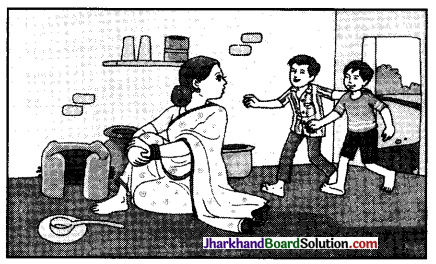
बड़ा लड़का अपनी उँगली से इशारा कर बोला – ” वहाँ दूर खेतों के पार बड़े- बड़े पेड़ हैं। वहाँ कई सूखी लकड़ियाँ गिरी होती हैं। हम उन्हें इकट्ठी कर लाते हैं।”
माँ ने कुछ देर सोचा और कहा – ” अच्छा जाओ। दोनों भाई इकट्ठे रहना। जंगल में बहुत आगे न जाना।’
देर से कुछ सोच दोनों लड़के लकड़ी लेने चले। आठ और दस वर्ष के दोनों भाई इतनी दूर अकेले कभी नहीं गए थे। जंगल में उन्हें आम के पेड़ के नीचे एक मोटी सूखी डाल दिखाई दी। वह आँधी से टूटकर नीचे गिरी थी।
बड़े भाई ने कहा – “ लकड़ी तो मिल गई, पर इसे हम लेकर कैसे जाएँगे ? यह तो बहुत भारी है। ”
छोटे ने कहा – ” हम इसे छोड़कर जाएँगे, तो कोई दूसरा उठा ले जाएगा।”
पर वे क्या करते ? इतनी बड़ी लकड़ी उनसे उठ नहीं सकती थी। दोनों चुपचाप लकड़ी पर बैठ गए। इतने में छोटा लड़का चिल्लाया- “देखो, वह क्या है ? इतनी चींटियाँ ! वे किसे ले जा रही हैं ?”
बड़े लड़के ने ध्यान से देखा और कहा – ” चींटियाँ मरे हुए एक मोटे कीड़े को खींच कर ले जा रही हैं।”
छोटा भाई हैरानी से बोला – ” इतनी छोटी-छोटी चींटियाँ इतने मोटे कीड़े को कैसे खींच सकती हैं?”
“यह तो मरा हुआ कीड़ा ही है। कभी-कभी तो चींटियाँ मरे हुए साँप को भी घसीटले जाती हैं” – बड़े भाई ने कहा।
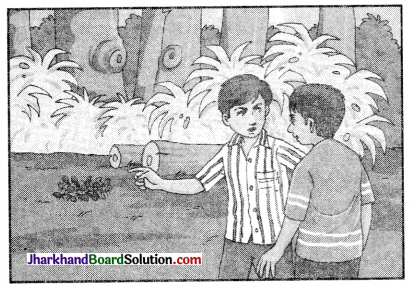
दोनों भाई चींटियों को ध्यान से देखने लगे। चींटियाँ धीरे-धीरे कीड़े को सरका रही थीं। कभी-कभी मोटा कीड़ा लुढ़क कर उन पर भी गिर जाता था। झट से दूसरी चींटियाँ दबी हुई चींटियों को कीड़े के नीचे से निकाल देती थीं। चींटियाँ अपने काम में लगातार लगी हुई थीं। थोड़ी ही देर में चींटियाँ कीड़े को सरका – सरका कर अपने बिल के पास ले गईं।
छोटा लड़का कुछ देर सोचता रहा। वह अपने भाई की ओर मुँह कर बोला –
” क्या हम चींटियों से भी कमज़ोर हैं ?”
बड़े लड़के ने कहा – “क्यों, क्या हुआ ? हम तो उनसे कई गुना बड़े हैं, ताकतवर हैं।”
“यदि चींटियाँ मोटे कीड़े को धकेलकर वहाँ तक ले जा सकती हैं तो हम इस लकड़ी को धकेलकर अपने घर क्यों नहीं ले जा सकते ? ” – छोटे लड़के ने कहा।
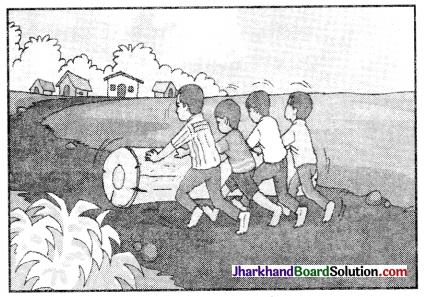
बड़ा लड़का उठकर खड़ा हो गया। वह बोला – ” तू यहीं बैठ। मैं अभी आया। ”
वह भाग कर गाँव वापस गया। वहाँ से अपने मित्रों को बुला लाया। मित्र अनेक थे। उन सबने मिल कर उस भारी लकड़ी को लुढ़काना आरंभ किया। सबने मिलकर खेल – ही खेल में वह लकड़ी उन दोनों भाइयों के घर पहुँचा दी।
माँ ने उन सबको शाबाशी दी और कहा – ” देखा तुमने। मिलकर काम करने से आप हर काम आसानी से कर सकते हो। सदा मिल-जुल कर काम किया करो। तुम्हारा हर काम हो जाएगा।”

(vii) परिचय देना, परिचय लेना –
हम-आप अपने-अपने समाज में रहते हैं। हम सदा एक-दूसरे का साथ पाना चाहते हैं और दूसरों को साथ देना चाहते हैं। अकेले तो हम रह ही नहीं पाते। समाज से कटकर अकेले रहना बहुत बड़ी सजा भोगने जैसा है। हमारी जान-पहचान पहले से ही अनेक लोगों से होती है पर जब हम किसी नए व्यक्ति के संपर्क में पहली बार आते हैं तो सबसे पहले हमें उससे परिचय प्राप्त करना होता है तथा उसे अपना परिचय देना होता है।
परिचय देना और परिचय लेना एक कला है। अपना परिचय देते समय हम पल भर में अपने व्यक्तित्व की पहली झलक किसी अपरिचित व्यक्ति को दे देते हैं। जब हम किसी को अपना परिचय देते हैं तब हमारे व्यवहार और हाव-भाव से अवश्य ऐसा झलकना चाहिए कि हम उससे अपना संपर्क बढ़ाना चाहते हैं। तब हमारे चेहरे पर उदासीनता या वितृष्णा के भाव कदापि नहीं होने चाहिए। हमारे चेहरे पर उत्साह और खुशी के भाव होने चाहिए तथा हमारी दृष्टि सामने वाले व्यक्ति पर होनी चाहिए। उसे ऐसा लगना चाहिए कि उससे मिलकर हमें प्रसन्नता हुई है।
I. परिचय देना :
परिचय के प्रकार – प्रायः परिचय दो प्रकार से दिया जाता है।
- अनौपचारिक परिचय
- औपचारिक परिचय
1. अनौपचारिक परिचय – इस प्रकार के परिचय में नाम, कक्षा या व्यवसाय का ही परिचय देना पर्याप्त होता है। यदि परिचय पाने वाला व्यक्ति आपके विषय में अधिक जानना चाहता है तो वह स्वयं बातों-बातों में आपसे पूछ लेगा।
उदाहरण –
(क) मेरा नाम रेवती है। मैं दयाल सिंह पब्लिक स्कूल में दसवीं कक्षा में पढ़ती हूँ।
(ख) मैं मोहित। दिल्ली पब्लिक स्कूल, आर० के० पुरम में नौवीं कक्षा का विद्यार्थी हूँ।

2. औपचारिक परिचय – इस प्रकार का परिचय प्रायः सभा सभाओं, सार्वजनिक कार्यक्रमों, कक्षा या बड़े समूहों में देना होता है। कई बार तो यह बता दिया जाता है कि परिचय देते समय क्या-क्या बताना होगा। सामान्य रूप से ऐसे परिचय में चार बातें बतानी होती हैं- नाम, कक्षा / व्यवसाय, विद्यालय / निवास, रुचियाँ।
उदाहरण –
(क) मेरा नाम पल्लवी है। मैं सेंट थैरेसा कान्वेंट स्कूल, करनाल में नौवीं कक्षा में पढ़ती हूँ। मैं न्यू हाउसिंग बोर्ड में रहती हूँ। कैरम खेलना, पेंटिंग करना और पुराने गाने सुनना मेरा शौक है।
(ख) मेरा नाम रोहन है। मैं डी० ए० वी० सीनियर सैकेंडरी स्कूल, जयपुर में ग्यारहवीं कक्षा का विद्यार्थी हूँ। मैं अपनी कक्षा का मॉनीटर हूँ। क्रिकेट खेलना मेरा शौक है। पत्र मित्रता करने में मेरी गहरी रुचि है।
अपने किसी सगे-संबंधी / मित्र / पड़ोसी का परिचय देना –
अपने परिचितों का किसी से परिचय कराते समय सदा ध्यान रखना चाहिए कि उनके विषय में कभी कोई ऐसी बात मुँह से नहीं निकलनी चाहिए जो उन्हें किसी भी प्रकार से बुरी लगे। सरल, सीधे और संतुलित शब्दों के प्रयोग से परिचय दिया जाना चाहिए। परिचय देते समय अतिशयोक्ति का प्रयोग नहीं करना चाहिए।
उदाहरण –
1. आपके साथ आपकी मम्मी विद्यालय के पुरस्कार वितरण समारोह में आई हैं। उनका परिचय अपनी कक्षा अध्यापिका को दीजिए।
उत्तर :
मैडम, ये मेरी मम्मी हैं। राजकीय महाविद्यालय में गणित की प्रध्यापिका हैं। मुझे पुरस्कार प्राप्त करते देखना चाहती हैं। ये आपसे मिलना भीं चाहती थीं !

2. आप बाज़ार जा रहे हैं। आपके साथ आपकी छोटी बहन है। उसका परिचय अपने मित्र से कराइए।
उत्तर :
यह उर्मि है, मेरी छोटी बहन। पाँचवीं कक्षा में पढ़ती है। इसे बाज़ार में खरीददारी करना अच्छा लगता है।
किसी प्रतिष्ठित व्यक्ति का परिचय कराना –
विद्यालय या किसी सार्वजनिक सभा में पधारे मुख्य अतिथि या किसी कलाकार का परिचय देना आवश्यक होता है। यह परिचय इस प्रकार दिया जाना चाहिए कि विशिष्ट व्यक्ति की विशेषताओं का संतुलित परिचय वहाँ उपस्थित लोगों को प्राप्त हो जाए। परिचय में अति विस्तार नहीं होना चाहिए और न ही कठिन भाषा का प्रयोग किया जाना चाहिए।
उदाहरण –
1. आपके विद्यालय में हरियाणा विद्यालय शिक्षा बोर्ड के पूर्व चेयरमैन डॉ० जयभगवान गोयल मुख्य अतिथि के रूप में पधारे हैं। हिंदी दिवस के अवसर पर वे अपने विचार प्रस्तुत करेंगे। आप उनका परिचय कराइए।
उत्तर :
प्रिय साथियो ! यह हमारा परम सौभाग्य है कि आज हिंदी दिवस के पुनीत अवसर पर हमारे बीच हिंदी साहित्य के परम विद्वान डॉ० जयभगवान गोयल पधारे हैं। हरियाणा विद्यालय शिक्षा बोर्ड के पूर्व चेयरमैन और कुरुक्षेत्र विश्वविद्यालय, कुरुक्षेत्र के हिंदी विभाग के अध्यक्ष अपने आपमें ही एक संस्था हैं। सैकड़ों पुस्तकों के रचयिता और सैकड़ों विद्यार्थियों को शोध कराने वाले शिक्षाविद् डॉ० गोयल वर्तमान में हिंदी-सेवा के प्रति समर्पित हैं। वे हमें हिंदी दिवस के महत्त्व से परिचित कराएँगे। मैं आप सबकी ओर से उनका स्वागत करते हुए उन्हें मंच पर सादर आमंत्रित करता हूँ
2. आपके विद्यालय में वार्षिक खेल-कूद प्रतियोगिता में मुख्य अतिथि के रूप में जिला के उपायुक्त पधारे हैं। उनका परिचय दीजिए।
उत्तर :
प्रिय मित्रो ! हमारे लिए अति हर्ष का विषय है कि आज हमारे बीच वह महान व्यक्तित्व खेल – कूद प्रतियोगिता के मुख्य अतिथि के रूप में पधारा है जिसने पिछले एक वर्ष में हमारे नगर की काया ही पलट दी है। अपनी दूरदृष्टि और अथक प्रयासों से हमारे आज के माननीय मुख्य अतिथि श्री राकेश देवगुण ने हमारे नगर को राज्य में एक नई पहचान प्रदान की है। ये केवल कुशल प्रशासक ही नहीं हैं बल्कि अपने समय के श्रेष्ठ खिलाड़ी भी रह चुके हैं। इन्होंने पोलो में भारतीय टीम का एशियन खेलों में प्रतिनिधित्व किया था। मैं उनके आगमन पर उनका हार्दिक आभार व्यक्त करते हुए उन्हें मंच पर आमंत्रित करता हूँ।

II. परिचय लेना :
हमें अपने जीवन में प्रतिदिन अनेक ऐसे लोग मिलते हैं, जिनसे हमारा पूर्व परिचय नहीं होता। हम किसी-न-किसी कारण उनसे परिचय पाना चाहते हैं। कई लोग हमें अच्छे लगते हैं और कई से हमारे कारोबारी संबंध होते हैं।
जब भी किसी अपरिचित से हम परिचय प्राप्त करना चाहते हैं, हमें भद्रता और शालीनता का परिचय देते हुए शिष्टाचार के सभी नियमों का पालन करना चाहिए। आरंभ में औपचारिकता बनी रहनी चाहिए और ‘आप’ शब्द का प्रयोग करना चाहिए। कभी भी ‘तू’ या ‘तुम’ जैसे शब्दों का प्रयोग नहीं करना चाहिए हँसी-मज़ाक और व्यंग्यात्मक शब्दों का प्रयोग तो कदापि नहीं करना चाहिए क्योंकि हम उस अपरिचित के स्वभाव को नहीं जानते। हमारा व्यंग्यात्मक शब्द उसे बुरा लग सकता है। परिचय प्राप्त करने से पहले सम्मानपूर्वक संबोधित करना आवश्यक होता है, जैसे –
भाई – साहब, बहन जी, अंकल, आंटी, मैडम, सर, श्रीमान जी, महोदय।
परिचय प्राप्त कर लेने के पश्चात मर्यादा का ध्यान रखते हुए नाम से भी संबोधित किया जा सकता है।
अपनत्व दिखाने के लिए बीच-बीच में नाम / जाति / संबोधन आदि का प्रयोग किया जा सकता है, जैसे-
(क) आपसे मैं पहले कह चुका हूँ, गुप्ता जी।
(ख) महेश जी, कभी उधर भी आइए।
(ग) अच्छा, बहन जी ! फिर मिलेंगे।
(घ) अरे, बेटा! मैं भी उधर ही जा रहा हूँ।
(ङ) वाह अंकल ! आप तो बहुत अच्छे हैं।

परिचय पाने के लिए संबोधन के साथ अभिवादन किया जाना चाहिए, जैसे –
(क) हैलो, सर !
(ख) नमस्ते अंकल !
(ग) आदाब, भाई जान !
(घ) नमस्कार जी।
(ङ) नमस्कार आंटी।
अभिवादन के बाद परिचय पूछा जा सकता है, जैसे –
(क) श्रीमान जी ! क्या मैं आपका शुभ नाम जान सकता हूँ?
(ख) कृपया अपना नाम बताइए।
(ग) सर ! क्या मैं आपका नाम पूछ सकता हूँ?
(घ) मैडम! क्या मैं आपका नाम जान सकता हूँ?

नाम जान लेने के पश्चात रहने का स्थान, नगर, स्कूल, कार्यालय, शिक्षा आदि के विषय में जानकारी प्राप्त की जा सकती है। परिचय प्राप्त करने के पश्चात औपचारिकतावश मिलने की खुशी अवश्य प्रकट की जानी चाहिए, जैसे –
(क) आपसे मिलकर बहुत प्रसन्नता हुई।
(ख) बहुत अच्छा लगा आपसे मिलकर, शर्मा जी।
(ग) फिर मिलना।
(घ) जल्दी फिर मिलेंगे।
(ङ) हमें आपसे मिलने का इंतजार रहेगा।
परिचय प्राप्त करने के पश्चात धन्यवाद अवश्य ज्ञापित करना चाहिए।
परिचय पाने के कुछ उदाहरण –
1. कक्षा में नया प्रवेश प्राप्त करने वाले एक लड़के से परिचय प्राप्त कीजिए।
उत्तर :
- आप – हैलो !
- वह – हैलो! आप ?
- आप – मैं रोहन हूँ और इसी कक्षा में पढ़ता हूँ।
- वह – मैं अनुराग हूँ।
- आप – आपको इस कक्षा में पहली बार देखा है।
- वह – हाँ। मैंने इस स्कूल में कल ही दाखिला लिया है।
- आप – पहले कहाँ पढ़ते थे?
- वह – मैं बेंगलुरू के मेरी कॉन्वेंट स्कूल में पढ़ता था।
- आप – क्या आपके पापा का ट्रांसफर हो गया है ?
- वह – हाँ।
- आप – कहाँ रह रहे हो ?
- वह – अभी तो घर ढूँढ़ रहे हैं। कुछ दिन के लिए गेस्ट हाउस में ठहरे हैं।
- आप – मेरे घर के सामने एक बड़ा-सा मकान किराए के लिए खाली है।
- वह – फिर तो बहुत अच्छा है। मैं पापा-मम्मी को बताऊँगा।
- आप – हम भी आस – पास रहकर दोस्त बन जाएँगे।
- वह – दोस्त तो हम बन भी गए। धन्यवाद।
- आप – धन्यवाद।

2. सब्ज़ी की रेहड़ी के निकट खड़ी एक औरत से आप उसका परिचय प्राप्त कीजिए।
उत्तर :
- आप – नमस्ते, बहन जी।
- वह – नमस्ते, आप ?
- आप – मैं नमिता हूँ। सामने वाले घर में रहती हूँ। और आप ?
- वह – मैं मीनाक्षी। पिछली गली में रहती हूँ।
- आप – कौन – सा मकान है आपका ?
- वह – कोने वाला।
- आप – अच्छा है। चलती हूँ। धन्यवाद।
- वह – प्रसन्नता हुई आप से मिलकर।
(viii) भावानुकूल संवाद – योजना –
जब भी दो या दो से अधिक लोग आपस में बातचीत करते हैं। तब भावों के अनुसार उन की वाणी और चेहरे के हाव-भावों में परिवर्तन दिखाई देता है। क्रोध की स्थिति में उनकी आवाज़ ऊँची और तेज़ हो जाती है तो करुण अवस्था में दुख की झलक अपने आप ही आवाज़ के माध्यम से प्रकट होने लगती है। प्रसन्नता के कारण आवाज़ में विशेष चहक – सी उत्पन्न हो जाती है। भक्ति भाव के समय वह शांत हो जाती है। शब्दों का चयन भी भावों के अनुरूप बदलता दिखाई देता है। स्वरों का उतार-चढ़ाव मानसिक स्थिति के अनुसार निश्चित रूप से नए – नए रूप लेता रहता है।
संवाद योजना सदा भावानुकल होनी चाहिए। इससे जब स्वभाविकता का गुण प्रकट होता है तब वह दूसरों को अधिक प्रभावित करता है। बातचीत में कभी बनावटीपन नहीं झलकना चाहिए। यदि किसी कहानी या नाटक के संवादों को बोला जाना हो तो व्यर्थ में बनावटी हाव-भाव कभी प्रकट नहीं किए जाने चाहिए। भावों और परिस्थितियों के अनुसार आंगिक क्रियाओं का संचालन किया जाना चाहिए।
संवादों को बोलने का अभ्यास निरंतरता की माँग करता है। दूसरों के सामने संवादों को बोलकर स्वयं को सुधारा और सँवारा जा सकता है। संवादों में छिपे भावों को केवल वाणी से ही नहीं बल्कि चेहरे के हाव-भावों से भी सरलतापूर्वक व्यक्त किया जा सकता है।

कुछ उदाहरण –
1. बोर्ड परीक्षा में पुत्र के प्रथम आने की सूचना को पाकर माता-पिता के बीच हुई बातचीत।
उत्तर :
- पिता (कंप्यूटर स्क्रीन को देखते हुए) – अरे, वाह ! कमाल कर दिया मोहित ने।
- माता – क्यों क्या हो गया ?
- पिता – देखो तो, उसका परीक्षा परिणाम आ गया है।
- माता (घबराकर) – पास तो हो गया है न वह।
- पिता – पास …….अरे ! उसने तो करिश्मा कर दिया है।
- माता – क्या स्कूल में फर्स्ट आ गया है।
- पिता – अरे नहीं ! वह तो पूरे राज्य में प्रथम आया है।
- माता – क्या ?
- पिता – हाँ, उसने तो पिछले बोर्ड परिणामों के सारे रिकार्ड तोड़ दिए हैं।
- माता – अरे वाह !
2. मित्र के दुर्घटनाग्रस्त हो जाने पर दो लड़कों के बीच हुए संवाद।
उत्तर :
- नरेंद्र (घबराए हुए स्वर में) – अरे, सुना तुमने !
- राघव – क्या ?
- नरेंद्र – परमजीत का एक्सीडेंट हो गया है।
- राघव – कब ? कैसे ?
- नरेंद्र – अभी, कुछ देर पहले। एक कार से।
- राघव – कहाँ है वह ?
- नरेंद्र – उसे अस्पताल ले गए हैं। बहुत खून बह रहा था उसका।
- राघव – क्या तूने उसे देखा ?
- नरेंद्र – हाँ। हम इकट्ठे ही तो खड़े थे स्कूल के बाहर।
- राघव – कैसे हुआ यह ?
- नरेंद्र – एक कार तेज़ गति से आई। उसने तिरछा कट मारा और परमजीत से उसकी साइड टकरा गई।
- राघव – तो ! कारवाला रुका क्या ?
- नरेंद्र – कहाँ ? वह तो भाग गया।
- राघव – क्या तूने उस का नंबर नोट किया ?
- नरेंद्र – हाँ! मैंने वह नंबर पुलिसवाले को दे दिया।
- राघव – चलो जल्दी। हम भी अस्पताल चलेंगे।
- नरेंद्र – हाँ, चलो।

3. पुस्तक मेले में जाने के लिए उत्सुक पुत्री और उसकी माँ के बीच के संवाद को लगभग 50 शब्दों में लिखिए।
उत्तर :
- पुत्री – माँ, माँ।
- माँ – क्या है? चिल्ला क्यों रही हो?
- पुत्री – माँ, हमारे विद्यालय से पुस्तक मेले में जाने के लिए नाम माँगे गए हैं।
- माँ – तो, मैं क्या करूँ?
- पुत्री – मैं भी जाना चाहती हूँ, इसलिए मुझे कुछ रुपए दे देना।
- माँ – क्या बेकार में वहाँ जाएगी? मैं तुझे शापिंग के लिए ले जाऊँगी।
- पुत्री – नहीं, मुझे पुस्तक मेले में जाना है, वहाँ ज्ञान-विज्ञान की नई-नई पुस्तकें देखने और जानने के लिए मिलेंगी।
- माँ – क्या रखा है, इस सबमें?
- पुत्री – माँ, पुस्तकें सच्ची मित्र होती हैं, इनसे हमारे ज्ञान में वृद्धि होती है।
- माँ – अच्छा, बाबा जैसी तेरी इच्छा ! अपना नाम लिखा देना और पैसे पापा से ले लेना।
- पुत्री – धन्यवाद, मेरी अच्छी माँ।

4. स्वच्छ अभियान पर माँ-बेटी के संवाद को लगभग 50 शब्दों में लिखिए।
उत्तर :
- माँ – रेखा, कमरे की क्या दुर्दशा कर रखी है, कहीं वस्त्र, कहीं पुस्तकें तो कहीं जूते ?
- रेखा – ठीक ही तो है माँ! जब जिस चीज़ की ज़रूरत होती है, ले लेती हूँ।
- माँ – फिर माँ मेरी पुस्तक, मेरी चप्पल, मेरा सूट कहाँ है कहकर चिल्लाती क्यों हो?
- रेखा – अरे माँ! वह तो यूँ ही …..।
- माँ – यूँ ही नहीं, स्वच्छता अभियान का अर्थ केवल झाडू लगाना नहीं होता बल्कि अपने कमरे में हर चीज़ ढंग से ठिकाने पर रखने से भी कमरा स्वच्छ और सुंदर लगता है।
- रेखा – समझी माँ, अब से हर चीज़ व्यवस्थित रूप से रखूँगी।
- माँ – तुम्हारा यह कार्य भी स्वच्छता अभियान का ही एक अंग होगा।
बोर्ड परीक्षाओं में पूछे गए संवाद लेखन संबंधी प्रश्न –
1. औलंपिक खेलों में भारतीय खिलाड़ियों के प्रदर्शन के बारे में अपने मित्र से हुए संवाद को लगभग 50 शब्दों में लिखिए।
![]()
![]()
![]()
![]()
![]()
![]()
![]()
![]()



